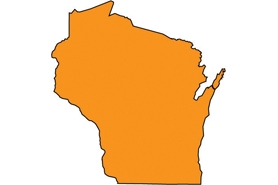White bedstraw
(Galium mollugo)
An erect, vine-like herbaceous perennial growing to 4 feet tall. Plants have tiny white flowers and long, slender whorled leaves.
Other names for this plant include:
- Common names: smooth bedstraw, false baby's-breath, wild madder
- Scientific names: Galium erectum, Galium mollugo var. erectum
Classification in Wisconsin: Restricted
- Ecological Threat
-
- It Invades grasslands, open woodlands, meadows, pastures, riverbanks, and disturbed areas such as roadside ditches.
- Tolerates various soil types, from silt and sand to dense red clays.
- A competitor to both long-lived and short-lived forage crops. Quickly crowds out native and non-native crop plants.
- It contains a toxin that causes toxicity in animals.
- Identification
-
Leaves & stems: Upright and branching thin stems, becoming matted as they age. Leaves are light green, with 6-8 leaves whorled on the stem—Lanceolate in shape and sessile (attaching to the branches without stalks).
Flowers: Small, whitish-green, 4-petaled flowers with four stamens and two styles. Branching inflorescence is a many-flowered panicle (cluster).
Fruits & seeds: Fruits are round and smooth. Each fruit contains two seeds, 1 mm in size, smooth and wrinkled.
Roots: Strong, deep taproot and shallow-rooted branching, woody rhizomes. The root system is reddish-orange and the rhizomes are yellow-orange.
Similar species: White bedstraw resembles numerous other Galium spp. Most notably, white bedstraw is smooth while many other species are "sticky" to the touch due to barbed hairs.
- Control
- Mechanical:
- Plants often reproduce vegetatively. Pull plants, being sure to remove rhizomes.
- Seeds do not persist in the soil; therefore, they control seed production by cutting or mowing.
- Mowing alone will not kill the plants but will stress the population, keeping it from producing seeds and spreading further. Note that mowing can apply to this plant if in the fruiting stage.
- Field infestations could be tilled and heavily seeded/planted with desired species.
- Monitor for re-growth.
- A combination of mechanical and herbicide treatments may be the most effective. This plant has a high tolerance for some herbicides.
- Apply Milestone or a triclopyr-based product to plants for the most effective control.
- Dicamba is also an effective herbicide when applied in spring to summer.
- Picloram is most effective when applied in autumn.
- Multiple herbicide applications are needed for adequate control.
- Cut or mow the population and apply herbicide to 2-week-old re-growth.
- Resources
- Sources for content:
- D. Mersereau and A. DiTommaso. 2002. Department of Crop and Soil Science, Cornell University, Ithaca, NY, USA. "The biology of Canadian weeds. 121. Galium mollugo"
- Wisconsin State Herbarium (WISFLORA) Department of Botany, University of Wisconsin - Madison
- University of Maine - Cooperative Extension
- Government of New Brunswick, Canada, Agriculture, Aquaculture and Fisheries



